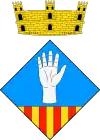Esplugues de Llobregat
Esplugues de Llobregat (Catalan pronunciation: [əsˈpluɣəz ðə ʎuβɾəˈɣat]) is a municipality of the Barcelona metropolitan area. It belongs to the comarca of Baix Llobregat,[4] Barcelona province, Catalonia, Spain.
Esplugues de Llobregat | |
|---|---|
 Pool of Can Clota | |
 Flag  Coat of arms | |
 Esplugues de Llobregat Location in Catalonia | |
| Coordinates: 41°22′36″N 2°5′9″E | |
| Country | |
| Autonomous community | |
| Province | Barcelona |
| Comarca | Baix Llobregat |
| Government | |
| • Mayor | Pilar Díaz Romero (2015)[1] |
| Area | |
| • Total | 4.6 km2 (1.8 sq mi) |
| Elevation | 110 m (360 ft) |
| Population (2018)[3] | |
| • Total | 46,355 |
| • Density | 10,000/km2 (26,000/sq mi) |
| Demonyms | Espluguí, espluguina |
| Time zone | UTC+1 (CET) |
| • Summer (DST) | UTC+2 (CEST) |
| Postal code | 08950 |
| Website | www |
During the recent decades Esplugues has evolved from a predominantly industrial city to a modern city with all services, preserving however its cultural and historical identity.
It is known for its characteristic old quarter, the only one in the Baix Llobregat area with such evocative and romantic areas as el Carrer de Montserrat and the palace of Can Cortada, which was home to the Baron Maldà, author of Calaix de Sastre, the most representative work of Catalan literature of the late 18th century. Esplugues holds a remarkable natural area with parks and green spaces such as the Park of Solidarity, the Park of Torrents and the Can Vidalet Park. From the mountain of Sant Pere Màrtir it is possible to enjoy a picturesque viewpoint of the entire town.
The German School of Barcelona and the American School of Barcelona are located in town and attract wealthy expatriate families who decide to get their kids educated there. Due to its proximity to the Camp Nou stadium, many famous footballers reside in Esplugues, such as Gerard Piqué and his wife Shakira, Andrés Iniesta, and Dani Alves, as well as the motorcycle racer Sete Gibernau, the former World Number 1 tennis player Arantxa Sánchez, and other personalities in the Spanish showbiz.[5]
City connection
Esplugues de Llobregat has an excellent road network, being connected to the highways B-20 and B-23, the N-340 road, and its location right across from the Avinguda Diagonal, the most important avenue in Barcelona. The city resides 11 km (7 mi) away from the Airport of Barcelona, it is 13 km (8 mi) away from the port of Barcelona, and 10 km (6 mi) away to the Catalan capital downtown.
It is linked to Barcelona through the following bus lines: 57, 63, 67, 68, 157, metropolitan buses, and T1, T2 and T3 Trambaix lines. The only metro station in the area is Can Vidalet, on the L5 line. Two other stops are under construction and will be opened in 2018.
History
The first nominal legal land section, a little portion of land with a few homes and a few inhabitants, in what is today Esplugues was made in 1096. The first documents which talk about a town called Esplugues de Llobregat date from the 14th century.
Demography
| 1900 | 1930 | 1950 | 1970 | 1986 | 2002 |
|---|---|---|---|---|---|
| 1057 | 3218 | 4318 | 29,474 | 47,670 | 46,447 |
Education
International schools in the municipality include:
Twin towns
 Ahrensburg, Germany
Ahrensburg, Germany Macael, Spain
Macael, Spain
Notable people
- Carme Chacón: Minister of Defence
- Óscar Jaenada: Actor
- Mercedes Milá: Journalist
- Lorenzo Milá: Journalist
- Pilar Giménez García: Musician
- Gerard Piqué: Footballer
References
- "Ajuntament d'Esplugues de Llobregat". Generalitat of Catalonia. Retrieved 13 November 2015.
- "El municipi en xifres: Esplugues de Llobregat". Statistical Institute of Catalonia. Retrieved 23 November 2015.
- Municipal Register of Spain 2018. National Statistics Institute.
- Esplugues de Llobregat became part of the Baix Llobregat in the comarcal revision of 1990. Previously it formed part of the Barcelonès.
- "Shakira y Gerard Piqué: su nueva casa en Ciudad Diagonal, el búnker de los famosos en Barcelona". Mujerhoy. 29 October 2012.
- "Adresse." German School of Barcelona. Retrieved on January 18, 2015. "Avda. Jacinto Esteva Fontanet, 105 E 08950 ESPLUGUES de Llobregat "
- "Home." American School of Barcelona. Retrieved on February 18, 2015. "Jaume Balmes, 7 08950 - Esplugues de Llobregat Barcelona - SPAIN"
.svg.png.webp)